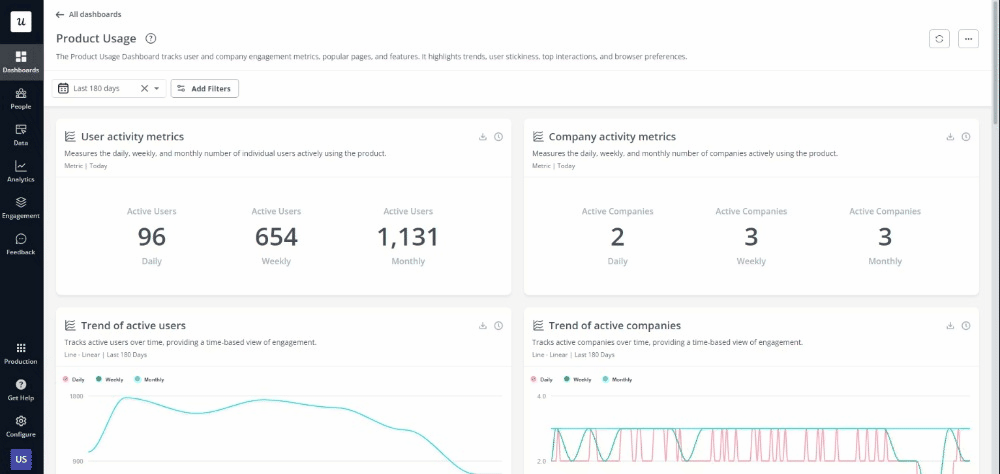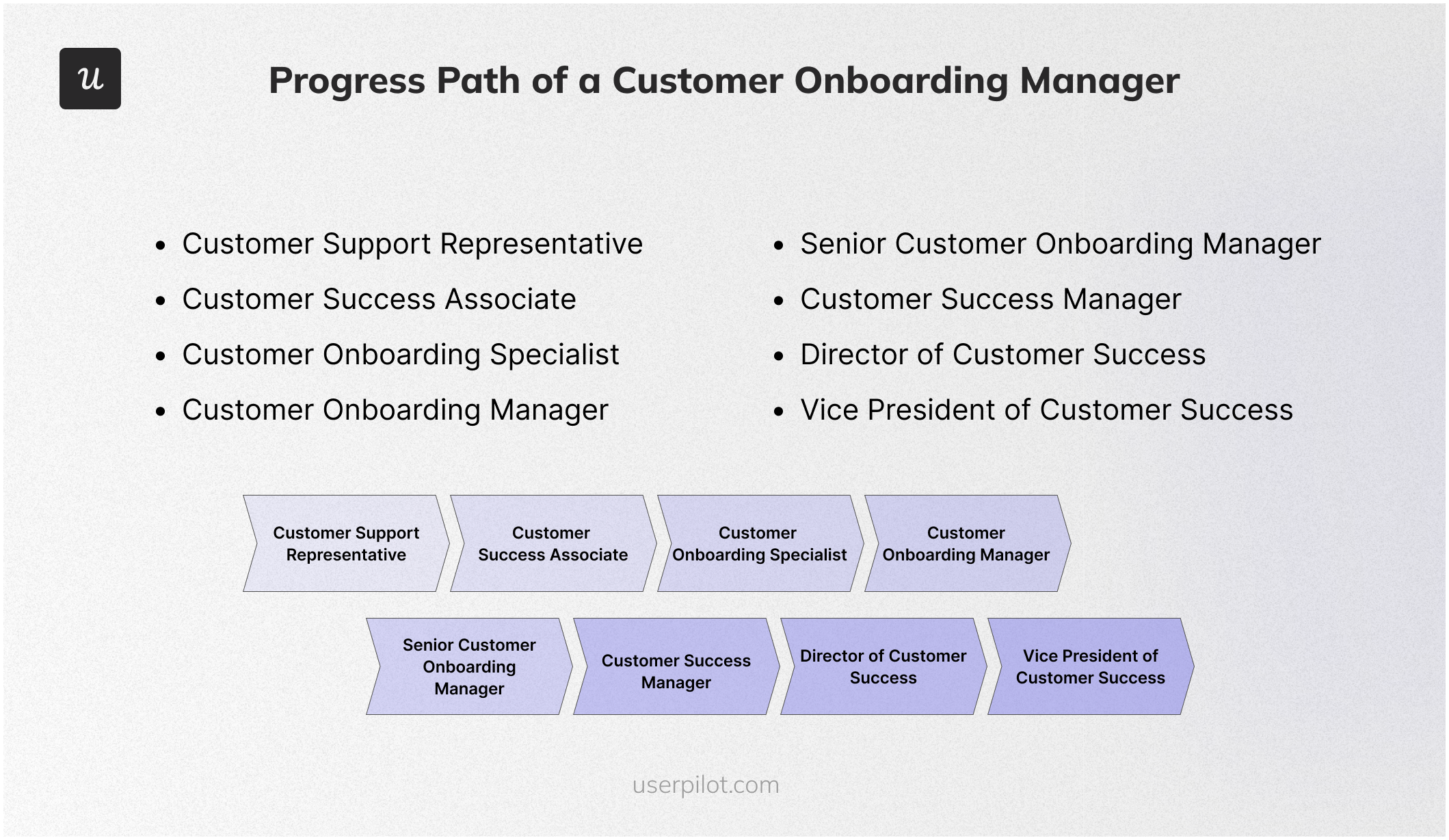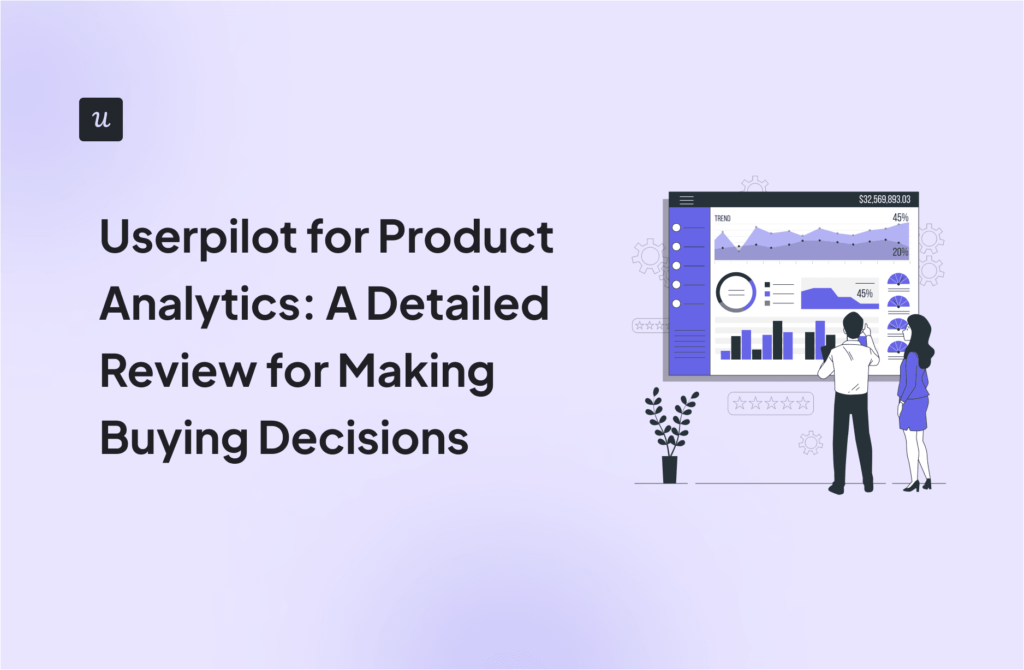![How to Become a Customer Onboarding Manager [+Tools and Resources]](https://blog-static.userpilot.com/blog/wp-content/uploads/2024/08/How-to-Become-a-Customer-Onboarding-Manager.png)
How to Become a Customer Onboarding Manager [+Tools and Resources]18 min read
Embarking on a career as a customer onboarding manager involves a combination of education, skills development, and practical experience.
Whether you’re just starting out or looking to transition into this role, understanding the key steps and requirements is essential.
This guide will provide you with a comprehensive overview of the path to becoming a successful customer onboarding manager.
Let’s dive in!
Get The Insights!
The fastest way to learn about Product Growth, Management & Trends.
TL;DR
- A customer onboarding manager is the person behind developing and implementing onboarding strategies to help SaaS customers move seamlessly from sign-up to effective product use. They understand customer needs, provide tailored training, and offer ongoing support to maximize product utilization and satisfaction.
- The typical career path for a customer onboarding manager includes:
- Customer Support Representative (entry-level, providing frontline support and gaining product knowledge)
- Customer Success Associate (assisting in ensuring customers achieve their desired outcomes)
- Customer Onboarding Specialist (guiding new customers through the onboarding process)
- Customer Onboarding Manager (overseeing the entire onboarding process and managing a team)
- Senior Customer Onboarding Manager (leading complex projects and mentoring junior managers)
- Customer Success Manager (ensuring overall customer satisfaction and retention)
- Director of Customer Success (overseeing the entire customer success department)
- Vice President of Customer Success (leading the customer success function at the executive level)
- To become a customer onboarding manager, pursue a bachelor’s degree in a relevant field, gain experience through internships or entry-level roles, and develop skills in customer service, project management, and data analysis. Certifications in customer success or project management can also be beneficial.
- Customer onboarding managers utilize various tools to enhance their work. Some essential tools include Userpilot for interactive product tours and user onboarding, Monday.com for project management, and Zendesk for customer success management.
- Looking into tools for customer onboarding managers? Userpilot is an all-in-one product platform with engagement features and powerful analytics capabilities. Book a demo to see it in action!
What is a customer onboarding manager?
A customer onboarding manager is the person behind developing and implementing onboarding strategies to help SaaS customers move seamlessly from sign-up to effective product use.
In the SaaS industry, this role involves understanding customer needs, providing tailored training, and offering ongoing support to maximize product utilization and satisfaction.
Key tasks include configuring the software, conducting training sessions, monitoring user engagement, and addressing any issues that arise during the onboarding phase. Their ultimate goal is to enhance customer satisfaction and drive long-term product usage.
Customer onboarding manager’s main responsibilities
Here are the main responsibilities and duties of a Customer Onboarding Manager, particularly in a SaaS (Software as a Service) environment:
Crafting the Onboarding Journey:
- Designing and Implementing the Program: This involves developing a comprehensive onboarding process that guides new customers from signup to product mastery. It might include elements like account setup workflows, personalized training modules, and interactive tutorials.
- Content Creation: They might create or curate onboarding content like knowledge base articles, video tutorials, and email drip campaigns to educate customers on product features and best practices.
- Streamlining Account Setup: They ensure a smooth and efficient account setup process, minimizing friction for new users.
Guiding and Supporting New Customers:
- User Training and Education: Customer onboarding managers deliver user training sessions, workshops, or one-on-one coaching to help customers understand the product’s functionalities and value proposition.
- Communication Champion: They maintain clear communication with new customers throughout the onboarding process, addressing questions promptly and fostering a sense of engagement. This might involve using various communication channels like email, phone calls, or live chat.
- Troubleshooting and Support: They provide initial troubleshooting support to new customers, resolving any technical issues or roadblocks they encounter during the onboarding phase.
Optimizing for Success:
- Metrics and Analytics: Customer onboarding managers track key onboarding metrics such as completion rates, time-to-value, and customer satisfaction. They analyze this data to identify areas for improvement and optimize the onboarding process for better user adoption and retention.
- Continuous Improvement: Based on data and customer feedback, they refine the onboarding program to ensure it remains effective and scalable as the product evolves.
Collaboration and Teamwork:
- Bridge Between Teams: They work closely with various teams within the organization, including sales, marketing, and customer success, to ensure a seamless handoff from initial acquisition to ongoing customer support.
- Alignment with Sales and Marketing: They collaborate with sales and marketing teams to ensure the onboarding experience aligns with the messaging and promises made during the pre-sales process.
- Providing Feedback: They provide valuable feedback to product development teams about user needs and challenges identified during the onboarding process.
In essence, customer onboarding managers are the orchestra conductors of the onboarding experience. They ensure all the elements work together to create a smooth and successful transition for new customers, ultimately driving product adoption and retention.
Customer onboarding manager career path
The career path for a customer onboarding manager typically involves progressing through various roles focused on customer support and success, each building the skills and experience needed for higher-level responsibilities.
- Customer Support Representative: Provide frontline support to customers, resolving issues and answering questions. Progression involves developing strong communication and problem-solving skills and gaining a deep understanding of the product.
- Customer Success Associate: Assist in ensuring customers achieve their desired outcomes through the company’s product or service. Progression involves focusing on building relationships and understanding customer needs and learning about customer success metrics and strategies.
- Customer Onboarding Specialist: Guide new customers through the onboarding process, ensuring they understand and can effectively use the product. Progression involves honing project management and training skills, and gaining experience in configuring and personalizing software for clients.
- Customer Onboarding Manager: Oversee the entire onboarding process, manage a team of onboarding specialists, and develop onboarding strategies. Progression involves focusing on leadership, strategic planning, and improving onboarding processes for better customer outcomes.
- Senior Customer Onboarding Manager: Lead complex onboarding projects, mentor junior managers, and collaborate with other departments to improve the customer journey. Progression involves developing expertise in customer success and onboarding and building a track record of successful onboarding initiatives.
- Customer Success Manager: Ensure overall customer satisfaction and retention, manage customer relationships, and work to maximize customer lifetime value. Progression involves leveraging onboarding experience to enhance customer success strategies and focusing on broader customer success metrics and long-term goals.
- Director of Customer Success: Oversee the entire customer success department, including onboarding, support, and retention strategies. Progression involves leading company-wide customer success initiatives, developing and implementing high-level strategies, and driving overall customer satisfaction and retention.
- Vice President of Customer Success: Lead the customer success function at the executive level, aligning customer success strategies with overall business goals. Progression involves influencing company strategy, working closely with other executives, and ensuring the customer success team drives significant business impact.
Each role requires a mix of customer-centric skills, product knowledge, and strategic thinking, with progression often involving increased responsibility, leadership, and influence within the company. Continuous learning and adapting to new customer success trends and technologies are crucial for advancement.
How to become a customer onboarding manager?
Launching a career in customer onboarding management requires a blend of skills and experience. Here’s a roadmap to get you started:
1. Build Your Educational Base:
- Pursue a bachelor’s degree in business administration, marketing, communication, or a related field. These programs provide a strong foundation in business principles, communication, and customer service – all crucial for onboarding success.
- Supplement your degree with online courses or certifications in project management and user experience (UX) design. These skills will be instrumental in designing smooth onboarding workflows and user journeys.
2. Gain Relevant Experience:
- Start with entry-level customer service, sales support, or technical support roles. These positions provide valuable experience in understanding customer needs, effective communication, and resolving issues – all transferable skills for customer onboarding.
- Look for internship opportunities at SaaS companies or startups specifically focused on customer onboarding. Here, you’ll gain hands-on experience with onboarding processes, product training, and real-world customer interactions.
3. Sharpen Your Onboarding Skillset:
- Actively develop your skillset! Take online courses or attend workshops on customer onboarding best practices, user onboarding tools, and data analysis. Platforms like Udemy, Coursera, and LinkedIn Learning offer numerous courses on these topics.
- Consider certifications in project management (like PMP) or UX design (like CUX) to showcase your dedication to the field and enhance your resume.
4. Network Like a Pro:
- Connect with customer success and onboarding professionals. Attend industry events (both online and in-person) to meet people in the field. Join online communities like Customer Success Slack groups or Facebook groups dedicated to customer onboarding.
- Leverage LinkedIn to connect with onboarding managers at companies you admire. Reach out with informational interviews to learn about their experiences and career paths.
5. Showcase Your Passion:
- Volunteer your onboarding expertise! Consider offering pro-bono onboarding consultations to small businesses or startups. This allows you to build a portfolio of your work and demonstrate your passion for the field.
- Start a blog or social media channel focused on customer onboarding best practices. Share your knowledge and insights to establish yourself as a thought leader in the space.
By taking these proactive steps, you’ll gain the necessary education, experience, and skills to launch a successful career in customer onboarding management. Remember, demonstrate your enthusiasm for creating exceptional customer experiences, and you’ll be well on your way to becoming a customer onboarding pro!
What skills should a customer onboarding manager have?
Customer onboarding managers are the secret weapon behind a seamless SaaS customer experience. They possess a unique blend of skills that bridge the gap between product knowledge and user satisfaction.
Here are the key skills that make a customer onboarding manager successful:
- Technical Expertise & Product Knowledge: They must have a deep understanding of the product’s features, functionalities, and value proposition. This allows them to effectively guide new customers and answer their questions with confidence.
- Communication Maestro: Excellent communication skills are paramount. They need to clearly explain complex topics in an understandable manner, both verbally and in writing. Active listening and the ability to tailor their communication style to different audiences are also essential.
- Training & Instructional Design: Customer onboarding managers are essentially teachers. They need the ability to design and deliver engaging training sessions that educate users on the product’s functionalities and best practices.
- Empathy & Customer Focus: Understanding customer needs and challenges is crucial. They should possess a genuine empathy for the user’s journey and strive to create a positive and supportive onboarding experience.
- Project Management & Organization: Onboarding programs often involve multiple steps and resources. Customer onboarding managers need excellent project management skills to keep the process organized, efficient, and on track.
- Data Analysis & Optimization: They should be comfortable analyzing onboarding metrics and user data to identify areas for improvement. This data-driven approach allows them to continuously refine the onboarding process for maximum impact.
- Collaboration & Teamwork: Customer onboarding is a collaborative effort. The ability to work effectively with different teams (sales, marketing, customer success) is essential for a smooth handoff and ongoing customer support.
Best certifications for customer onboarding managers
- Customer Success Certification by Gainsight – A comprehensive certification program covering various aspects of customer success, including onboarding, with a focus on practical skills and knowledge.
- Certified Customer Success Manager (CCSM) by SuccessCOACHING – Focuses on the skills needed to be an effective customer success manager, including onboarding strategies, with a mix of online courses and practical exercises.
- Customer Success Leader by LinkedIn Learning – Offers courses on leading customer success initiatives, with modules on onboarding, designed for professionals looking to advance their careers.
- Customer Onboarding Specialist Certification by Udemy – Specializes in the onboarding process, from initial setup to customer education, with video lectures, quizzes, and hands-on projects.
- Practical CSM by Practical CSM Academy – Provides practical training and certification for customer success managers, including onboarding, with a focus on real-world applications and best practices.
Best resources for customer onboarding managers
Navigating the vast world of resources can be overwhelming, but worry not! We’ve curated a list of the best books, webinars, podcasts, blogs, and certifications tailored for Customer Onboarding Managers.
Whether you’re looking to deepen your knowledge, stay updated with industry trends, or boost your career, these resources have got you covered.
Best books for customer onboarding managers
- “Onboarding Matters” by Donna Weber – This book provides a detailed framework for building an onboarding program that drives customer success and retention, with actionable insights and real-world examples.
- “The Customer Success Professional’s Handbook” by Ashvin Vaidyanathan and Ruben Rabago – A comprehensive guide to building customer success teams and strategies, including onboarding best practices, with tips on measuring success and optimizing processes.
- “The Effortless Experience” by Matthew Dixon, Nick Toman, and Rick DeLisi – Learn how to create a seamless and low-effort customer experience from onboarding to ongoing support, featuring case studies from leading companies.
- “Customer Success: How Innovative Companies Are Reducing Churn and Growing Recurring Revenue” by Nick Mehta, Dan Steinman, and Lincoln Murphy – This book delves into strategies for managing customer relationships, including effective onboarding techniques, with a focus on reducing churn and driving growth.
- “Nailing It: How to Build a Customer Onboarding Process That Ensures High Adoption Rates” by Donna Weber – Focuses specifically on the onboarding process and how to ensure customers reach their first value quickly, with step-by-step guidance and best practices.
Best webinars for customer onboarding managers
- Userpilot Webinar Series – A series of webinars focusing on product adoption, user onboarding, and customer success strategies, featuring industry experts and practical advice.
- “Onboarding New Customers: The First 90 Days” by Gainsight – Insights into the critical first 90 days of customer onboarding and how to set up for success, including metrics to track and common pitfalls to avoid.
- “Effective Customer Onboarding Strategies” by ChurnZero – Learn about different strategies and tools to enhance your customer onboarding process, with a focus on improving user engagement and satisfaction.
- “Customer Onboarding: Best Practices and Pitfalls” by Totango – Practical advice on what to do and what to avoid in customer onboarding, featuring case studies and real-world examples.
- “Scaling Customer Onboarding” by SuccessHACKER – Strategies to scale your onboarding process as your customer base grows, with tips on automating processes and maintaining a personal touch.
Best blogs for customer onboarding managers
- Userpilot Blog – Features articles on user onboarding, product adoption, and customer success, with practical tips and industry insights.
- Gainsight Blog – Offers insights into customer success strategies, including onboarding best practices, with contributions from thought leaders and practitioners.
- ChurnZero Blog – Covers a wide range of topics related to customer success and onboarding, with actionable advice and success stories from the field.
- SuccessCOACHING Blog – Provides tips and strategies for customer success managers, including onboarding techniques, with a focus on professional development and best practices.
- Customer Success Box Blog – Insights and best practices for onboarding and retaining customers, with a mix of how-to guides, case studies, and expert opinions.
Best podcasts for customer onboarding managers
- “Customer Success Leader” by Gainsight – Discusses various aspects of customer success, including onboarding, with industry leaders sharing their experiences and insights.
- “Helping Sells Radio” by ServiceRocket – Explores how to help customers be successful, with episodes on onboarding strategies and tips from customer success professionals.
- “The Customer Success Podcast” by Totango – Features conversations with CS leaders on building and scaling customer success, including onboarding, with a focus on practical advice and best practices.
- “The Onboarding Show” by Rocketlane – Focuses specifically on onboarding and implementation strategies for SaaS companies, with interviews and case studies from industry experts.
- “Customer Success Conversations” by Customer Success Network – Engaging discussions on various CS topics, including effective onboarding practices, with a mix of solo episodes and guest interviews.
Best tools for customer onboarding managers
Equipping yourself with the right tools is essential for streamlining your customer onboarding process and creating a smooth, positive experience for new users.
Here’s a list of 10 top-rated options to consider:
- Interactive Product Tours & User Onboarding (incl. Automation & Personalization): Userpilot – Create interactive tours, walkthroughs, feature spotlights, and personalized onboarding flows – all within one platform. Guide users, increase adoption, reduce tickets, and tailor experiences.
- Project Management for Onboarding Workflows: Monday.com – Manage onboarding tasks, track progress, and collaborate with different teams for seamless customer handoffs through a user-friendly visual interface.
- Customer Success Platform: Zendesk – Offer a comprehensive platform with ticketing systems, knowledge base creation tools, and live chat functionalities for effective communication and support throughout the onboarding journey.
- Design & Prototype Onboarding Experiences: Figma – Design high-fidelity mockups and prototypes of onboarding screens and user interfaces to ensure a smooth and intuitive user experience.
- Data Analysis & User Insights: Tableau- Transform onboarding metrics into clear and actionable insights with data visualization tools. Identify improvement areas and optimize your program for better results.
- User Experience Research & Feedback: Hotjar – Gather user feedback through heatmaps, recordings, and surveys. Understand user pain points and refine your onboarding experience based on their insights.
- Knowledge Base & Content Management: Notion – Create and organize onboarding content (text guides, video tutorials, FAQs) within a flexible workspace. Facilitate collaboration and version control.
- Task Management & Team Communication: Trello – Manage onboarding tasks, assign them to team members and track progress collaboratively using visual Kanban boards. Foster transparent and efficient workflows.
- Alternative User Onboarding Automation Tool (if needed): WalkMe – Create automated in-app walkthroughs and feature spotlights to guide users and answer questions within the application.
- Alternative Personalization Tool (if needed): Pendo – Create targeted onboarding flows and in-app messages for different user segments, ensuring they receive the most relevant and valuable information.
By leveraging these tools strategically, you can create a best-in-class customer onboarding experience that drives user adoption, reduces churn, and sets your customers up for long-term success.
Remember, Userpilot can be a powerful one-stop shop for many of your onboarding needs, including automation and personalization. However, the additional options provide a well-rounded toolbox for specific areas you might want to explore further.
Customer onboarding manager FAQs
What are the key metrics for measuring successful customer onboarding?
Success in onboarding goes beyond vanity metrics. Track metrics that reflect user activation, engagement, and value realization. Here are some key ones:
- Time-to-value (TTv): How quickly do customers achieve their first win with your product?
- Feature adoption: Are users exploring and utilizing core functionalities?
- Customer churn rate: How many customers are canceling after onboarding?
- Net Promoter Score (NPS): How likely are customers to recommend your product after onboarding?
- Customer Satisfaction (CSAT): Are customers happy with their onboarding experience?
How can I personalize the onboarding experience for different customer segments?
Personalization fosters a more engaging experience. Consider segmenting users based on factors like company size, industry, or signup plan. Here’s how:
- Tailor content: Provide targeted onboarding materials (e.g., guides, tutorials) relevant to specific user needs and goals.
- Highlight relevant features: Showcase functionalities that directly address each segment’s pain points.
- Utilize user data: Leverage onboarding behavior to personalize in-app messages and recommendations.
What are the best practices for creating effective onboarding content?
Effective onboarding content is clear, concise, and action-oriented. Here are some best practices:
- Keep it focused: Prioritize essential information and avoid overwhelming users.
- Use visuals: Screenshots, explainer videos, and infographics enhance understanding.
- Offer multiple formats: Cater to different learning styles with text guides, video tutorials, and interactive elements.
- Maintain a clear tone: Use a conversational yet professional tone that aligns with your brand voice.
How can I automate tasks to streamline the onboarding process?
Automation frees you to focus on strategic initiatives. Here are areas for automation:
- Welcome emails: Set up automated email sequences to deliver key information at pre-defined intervals.
- In-app walkthroughs: Create automated tooltips and product tours that guide users through core functionalities.
- Task management: Utilize project management tools to automate task assignments and track onboarding progress for different users.
How can I measure the ROI (return on investment) of my customer onboarding program?
Onboarding directly impacts customer acquisition and retention. Here’s how to measure ROI:
- Calculate customer lifetime value (CLTV): This metric estimates the total revenue a customer generates over their relationship with your company. Increased onboarding effectiveness typically leads to higher CLTV.
- Track customer acquisition costs (CAC): Effective onboarding reduces churn and the need for reacquisition efforts, lowering CAC.
- Analyze onboarding program costs: Compare the costs of your onboarding program with the revenue gains from improved customer acquisition and retention.
Conclusion
Becoming a successful customer onboarding manager requires dedication, continuous learning, and a proactive approach to developing relevant skills.
By following the outlined steps and leveraging the resources available, you can effectively navigate your career path and achieve your professional goals.
We hope this guide has provided you with valuable insights and practical advice to help you on your journey to becoming a proficient and impactful customer onboarding manager!
Looking into tools for customer onboarding managers? Userpilot is an all-in-one product platform with engagement features and powerful analytics capabilities. Book a demo to see it in action!









